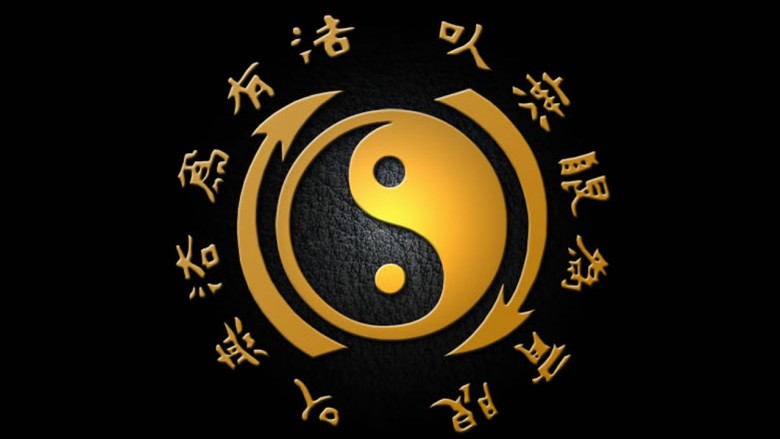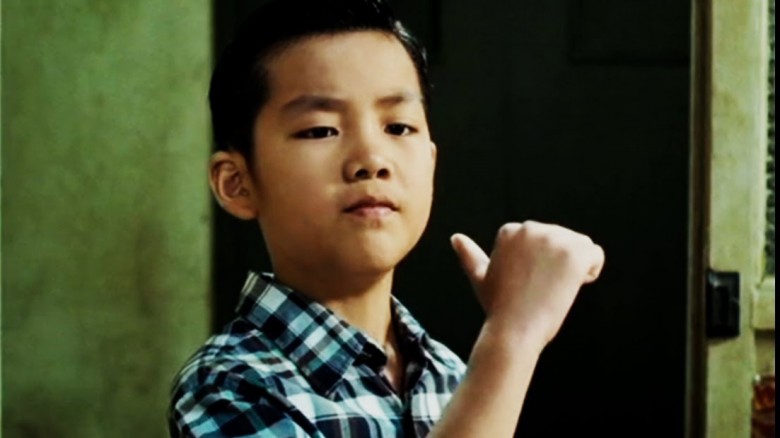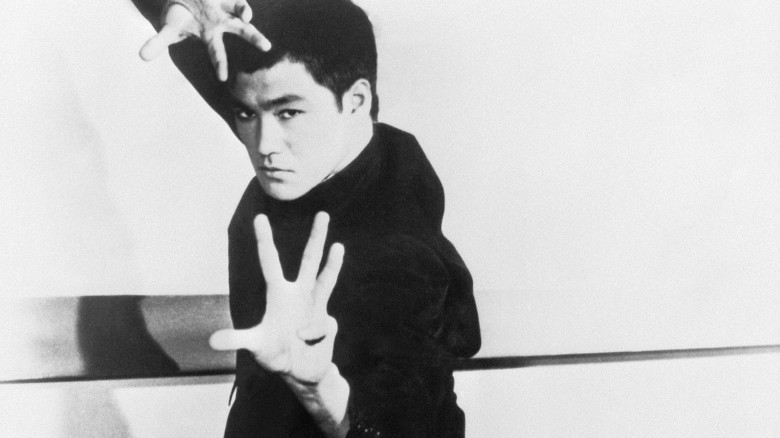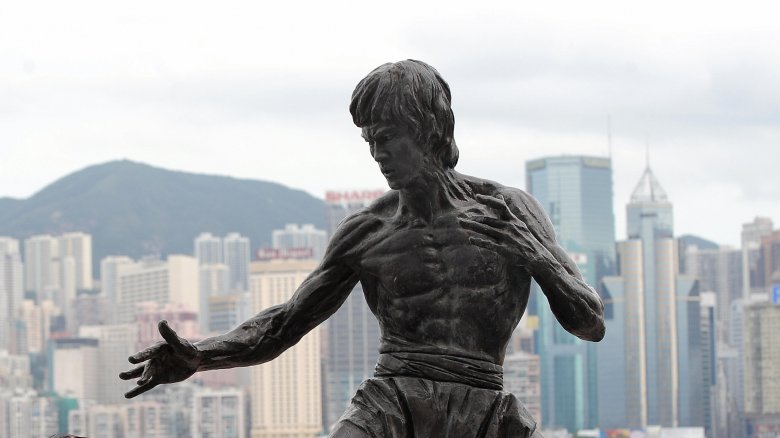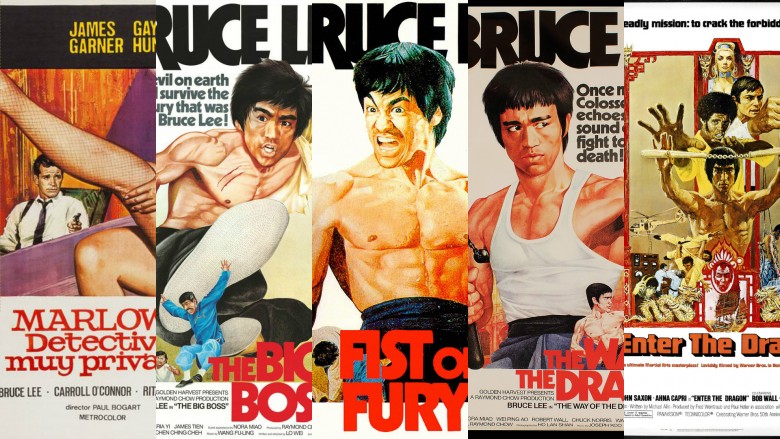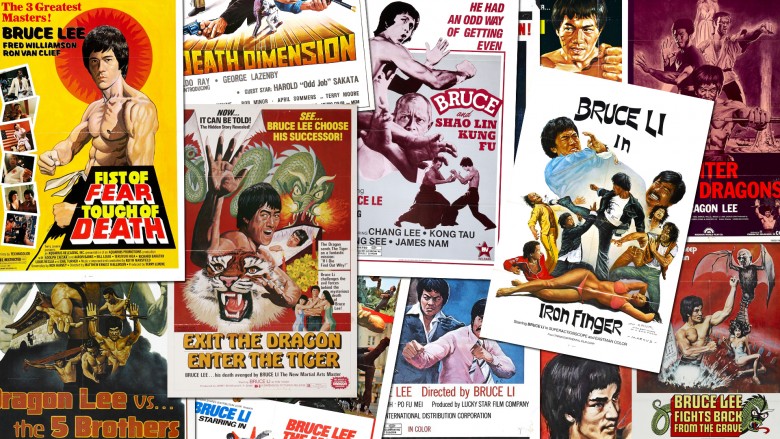The Untold Truth Of Bruce Lee
Few people have had the social impact Bruce Lee did. Just about everyone knows who he was and what he did, but there are many aspects of his life that the public never got to see. Such as ...
He wasn't a master of any standard form of martial arts
Ask anyone about Bruce Lee and they will undoubtedly point out that he was a master martial artist. They may even say he was a master of Kung Fu, but the truth is, he never mastered any martial art practiced throughout the world. That isn't to say he didn't know what he was doing, and that he couldn't kick pretty much everyone's ass if the mood struck him — he just didn't pick one way to do it. He picked them all.
It's said that Lee only ever lost one fight, when he was 14 years old. He had no training at this point, but the experience spurred his need to learn to defend himself. This eventually brought him under the influence and tutelage of Yip Man in 1957, who taught Lee Wing Chun. If Lee was close to mastering any martial art, it was Wing Chun.
So why did the great Lee not technically master anything? Most likely it's because, due to Lee's mixed ancestry, he had a difficult time finding a sparring partner to train with. Chinese custom frowns on teaching martial arts to foreigners, and Lee's mother was half-Chinese and half-Caucasian, which many thought inappropriate. Because of this, Lee was taught directly by Yip Man, which helped to influence his studies considerably. But before Lee could complete his training, he moved to the United States to continue his education. He ended up settling in Seattle in 1959 before he moved to Minnesota to attend college in 1960.
Lee didn't abandon martial arts when he left Hong Kong (obviously), but his formal instruction in Wing Chun came to an end, leaving him without the training necessary to completely master the form.
He invented his own style of martial arts
After leaving Hong Kong, Lee began to teach his own form of martial arts. He based his style on the teaching of Man and what he learned of Wing Chun, but called his form Jun Fan Gung Fu, which translates into Bruce Lee's Kung Fu. He was a very humble man.
Lee opened his first martial arts studio in Seattle, which he called the Lee Jun Fan Gung Fu Institute. He continued to develop his style until he created Jeet Kune Do in 1967. Jeet Kune Do evolved after Lee's fight with Wong Jack Man in 1964, a fight that arose due to Lee's insistence on teaching non-Chinese students. The fight went on for 20 minutes — upon reflection, Lee concluded that lasted too long, and the form of Kung Fu he was following was too formalistic to be practical. This led to the evolution of Jeet Kune Do, a system of fighting that abandons the rigidity of established forms, and places an emphasis on practicality, flexibility, efficiency, speed, and physique.
Lee built upon his already established physical regimen, to improve his physique to Captain America levels. Fitness and nutrition became paramount in his training and he formalized Jeet Kune Do as a new martial arts. He called it "the style of no style," emphasizing the abandonment of a formalized approach to training. Lee's influences in establishing his new style came from fencing, western-style boxing, and Wing Chun. Jeet Kune Do is still practiced thanks to Lee's influence and teachings. Some notable practitioners include his son Brandon Lee, Kareem Abdul-Jabbar, Lady Gaga, and Nicholas Cage, among many others.
He was a child actor, having starred in 20 films in Hong Kong before the age of 18
It's hard to find someone who doesn't know Bruce Lee and his work like Enter the Dragon, but most people aren't aware of his prolific body of work prior to his worldwide fame. Bruce Lee was acting since he was a little kid—he even worked on a film at the tender age of three months! In the 1941 film Golden Gate Girl, he played a Chinese baby, which ... let's face it, he nailed it! He didn't do much more until the age of six, when he starred in The Beginning of a Boy. By his 18th birthday, he had performed in 20 films, his last child-star role being was the film The Orphan, in 1960.
Most of Lee's work from his adolescence is unknown outside of China and Hong Kong, but over there, it's no state secret. Finding his Hong Kong work in English and other languages can be difficult, but anyone so inclined to check them out can usually find them at the Hong Kong Film Archive, thanks to their lapsing into the public domain. While there are no official translations into other languages, some intrepid fans have compiled English subtitles on choice features, so the films can be enjoyed by fans outside of China.
He popularized the "1 Inch Punch" as seen in Kill Bill Vol. 2
Remember that scene in Kill Bill: Volume 2 when Uma Thurman's The Bride is buried alive and has to one-inch punch her way out of her coffin? Most people watching something like that would probably dismiss it as an impossibility, or a gimmick, but it was based off of something Bruce Lee often did at performances.
Basically, Lee would stand in front of a volunteer, who would have a board or some other protective gear covering their chest. Behind them would be a chair, and Lee would place his fingers on their chest in preparation for the punch. Within an instant, Lee would pull his fingers into a fist and punch with all his (considerable) strength. The result often caused the volunteer to slam back into the chair, and slide back a few feet. People have been studying just how the legendary martial artist pulled off this feat for years.
According to biomechanical researcher, Jessica Rose or Stanford University, "When watching the one-inch punch, you can see that his leading and trailing legs straighten with a rapid, explosive knee extension." This forces the speed of his twisting hips to increase, which lurches his shoulder forward. He was literally putting his entire body — and likely most of his resting energy — into each punch. Lee would instantly pull his fist back, which shortened the impact time. This compressed the force, and made the punch all the more powerful.
He was a prolific poet and philosopher
Hardly anyone would think of Bruce Lee as a poet or philosopher, but that's exactly what he was. He studied poetry and philosophy in school, and was even published several times. While studying at the University of Washington, he focused his studies on Asian and Western philosophy, incorporating elements of Jiddu, Buddhism, Taoism, and Krishnamurti. This helped him to better understand himself and how he and his martial arts were more a method of self-expression of his philosophy than anything else.
His understanding of philosophy helped to develop his love of poetry, which he used as an expression of his emotions. Most of his published work was compiled and edited by John Little, who described his poems as "...by American standards, rather dark — reflecting the deeper, less exposed recesses of the human psyche ... Many seem to express a returning sentiment of the fleeting nature of life, love and the passion of human longing."
He also read throughout his life, and maintained a rather impressive library in his home. At his death, his library boasted more than 2,500 books, many of which focused on martial arts and philosophy. Shortly before his death, Lee wrote a personal essay called "In My Own Process," where he reflected on his role in the world. "Basically, I have always been a martial artist by choice and actor by profession. But, above all, I am hoping to actualize myself to be an artist of life along the way."
He was so fast, his moves were often too fast for a camera to catch
Bruce Lee's speed is the stuff of legend. Anyone who's ever seen a video of the man doing ... well, anything, has seen that the way he moved defied logic, physics, and the natural world. His tremendous speed was the result of his devotion to nutrition and fitness, which sculpted his body into perfection. His blows were so fast, they were unblockable by just about everyone who ever tried to face him.
This made some people think his moves were supernaturally fast, since you could barely see them on camera. In reality, he moved so, fast they just didn't need to do any enhancements on the film to make him look faster than he actually was. In many scenes, he actually needed to slow down to make the film look realistic. He was that fast.
He only made five feature films in the US, his last released posthumously
Some may remember him from his role as Kato on The Green Hornet, but most people recognize Bruce Lee as the leading man in films like Enter the Dragon and Fist of Fury. By the time he died at the age of 32, Lee had only acted in five major American productions. His first, Marlowe, had him playing a supporting role. It wasn't until The Big Boss that we got to see Bruce Lee playing, well, Bruce Lee. He followed this up with Fist of Fury, The Way of the Dragon, and his most well-known film, Enter the Dragon.
Sadly, Lee never got to see the recognition Enter the Dragon has received, since he died shortly after filming it. It's been selected for preservation in the National Film Registry, noting it as being historically significant. Enter the Dragon was so successful, it spawned a Kung Fu craze, which resulted in a massive influx of Chinese-influenced martial arts films, all of which could conceivably be subtitled Not Bruce Lee, So Why Bother?
He died after taking medication for a headache due to a severe allergy to painkillers
Bruce Lee's death was a tragic accident nobody could have predicted. His brain had swollen considerably, having increased by 13%, due to an allergic reaction Lee had to meprobamate. For a man whose entire adult life was about nutrition and fitness, his passing as a result of a single pill taken for something as simple as a headache was difficult for fans to take.
His death was officially ruled "death by misadventure," a ruling coroners use for someone who dies of an accident, usually after engaging in risky behavior, though it's hard to seriously consider taking a headache pill "risky."
Rumors about a conspiracy and murder began popping up in the media, but the conclusion was certain — Lee died from a cerebral edema. What's worst is, this edema may have been treatable, had he been seen by a doctor sooner.
His death brought on Bruceploitation and a lot of bad movies
We already know that Lee's death brought about the so-called Kung Fu craze in Western markets, but the nature of that craze tended to take a rather exploitative approach ... it was actually dubbed Bruceploitation, and it's easy to see why.
Shortly after Lee died, filmmakers in China, Hong Kong, and Taiwan began hiring anyone who looked anything like Lee and put them in crappy martial arts films, hoping to bank on the deceased star's popularity, look, and style. Not only did the studios hire men who looked like Lee, these guys ended up changing their names to sound something like him as well. Bruce Li, Bruce Lai, Dragon Lee, Bruce Leong, and Bruce Le were prolific throughout the '70s, and most of the movies were pretty awful, though some rare gems did shine through.
Some of the most notorious Bruceploitation films are Bruce Lee: The Man, The Myth; Enter The Game Of Death; The Dragon Lives Again; My Name Called Bruce; Exit The Dragon Enter The Tiger' Challenge of the Tiger' and Game of Death. The latter represents a rare example of a decent flick that used stock footage and shots made for the film prior to Lee's death. He filmed scenes for Game of Death in 1972, but never completed it.
Watching any of these films without your glasses on might lead you to believe you have luckily stumbled upon some lost Lee work, but a clearer viewing will show you that the actors are all lookalikes, and they pale in comparison to the real thing.

